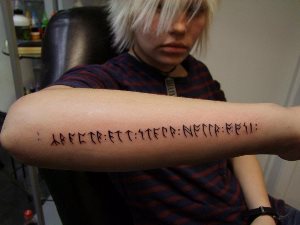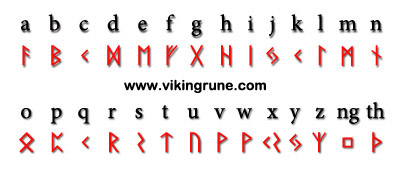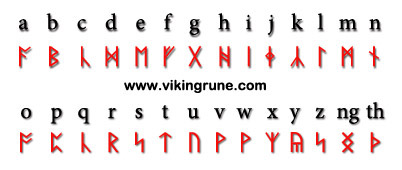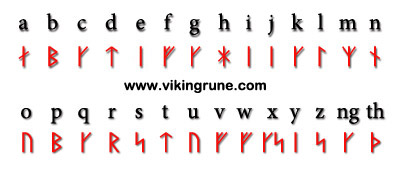 Developing a great design for a tattoo is critical in case you seriously plan to get inked. If you are about to have a Norse or Viking tattoo, I bet you want to include some Nordic runes into it. Tattooed inscriptions in foreign languages or written in unusual characters may well be a source of trouble, especially if you don’t know well the language or the writing system. Online translation tools may play a trick on you: a woman who wanted to have “I love David” in Hebrew on her back, later realized the actual tattoo said “Babylon is the world’s leading dictionary and translation software”. David Beckham inked his wife’s name on his left forearm in Hindi but misspelt it. The tattoo read Vihctoria instead of Victoria with additional h. The name is well known in India because of Queen Victoria, so the person who developed the tattoo design probably wasn’t a native Hindi speaker and even did not know the language well. Perhaps you wouldn’t like to be in such a situation with your runic inscription, would you?
Developing a great design for a tattoo is critical in case you seriously plan to get inked. If you are about to have a Norse or Viking tattoo, I bet you want to include some Nordic runes into it. Tattooed inscriptions in foreign languages or written in unusual characters may well be a source of trouble, especially if you don’t know well the language or the writing system. Online translation tools may play a trick on you: a woman who wanted to have “I love David” in Hebrew on her back, later realized the actual tattoo said “Babylon is the world’s leading dictionary and translation software”. David Beckham inked his wife’s name on his left forearm in Hindi but misspelt it. The tattoo read Vihctoria instead of Victoria with additional h. The name is well known in India because of Queen Victoria, so the person who developed the tattoo design probably wasn’t a native Hindi speaker and even did not know the language well. Perhaps you wouldn’t like to be in such a situation with your runic inscription, would you?
Many runic tattoo designs include a name. You may want to have inked in runes the name of a beloved one, your own name, or a name of a deceased person who was important in your life. Now if we are to spell it in the Elder Futhark runes, we have to look deeper into what spelling is and have a look at the following facts:
-
The ideal alphabet has a separate symbol (letter or rune) for each sound the language has.
-
The Elder Futhark runic alphabet was such an ideal system: there are as many Elder Futhark runes as there were sounds in the Proto-Norse language, for which they were developed.
-
Roman letters used to transcribe the English language today do not constitute an ideal alphabet. Several sounds (have a look at the IPA chart of English) do not have letters of their own. They are transcribed with letters or combinations of letters used for other sounds as in ch for [tʃ] and sh for [ʃ].
-
The Phonological system (sound system) of the Proto-Norse language was not the same as in modern English. It had sounds that do not exist in English. It also did not have some sounds that do exist in English: for instance English has the sounds [tʃ] [dʒ] [ʃ] [ʒ], whereas Proto-Norse did not have them.
-
If we try to use the Elder Futhark runes phonetically, that is substituting runes for the sounds we hear, the way runes were supposed to be used, we will fail, because there are not enough runes for all the English sounds.
So the solution is to keep modern English spelling. It is true that ancient rune carvers did not use it. However, it is also true that they did not have to transcribe words containing sounds like [tʃ] [dʒ] [ʃ] [ʒ]. Should they have to, they would invent a way to do so. Not necessarily combining s and h for [ʃ] as in ‘shame’ or c and h for [tʃ] as in ‘child’. May be they would even invent something more logical than using as many as three variants for one and the same sound [dʒ] as in ‘gin’, ‘joy’, and ‘edge’.
Even though keeping the English orthography eliminates the most of the problems, some still remain. First, there are 26 Roman letters in the English alphabet and only 24 runes in the Elder Futhark. Second, not all of the runes have obvious counterparts in Roman letters, for instance the *eihwaz rune denoted a phoneme with the sound value between [i] and [e]. Since we have *isa and *ehwaz for English i and e, *eihwaz remains unemplyed. Below is a table of letters and their runic counterparts, showing how all this can be resolved:

Note that this way to collate letters and runes is not canonical. It is based on my own understanding of phonology and orthography. No one has ever decreed ex cathedra that such a set of counterparts—fixed as the ‘right’ or ‘correct’ one—should at all exist. There has been no social contract concluded to this effect, either. An algorithm based on this table is behind the rune converter that I developed. You may see other tables of counterparts on the Internet that suggest different solutions. Keep in mind that you may also find phonetic explanations of runes, which were not compiled as a help for those who want to write a name in runic symbols. In such cases as my earlier post the counterparts denote the letters used to transcribe ancient runic inscriptions. Here is also the table for the Anglo-Saxon runes known as the Anglo-Saxon Futhorc:

The Younger Futhark runic alphabet has only 16 runes. It uses one and the same rune for such pairs as [p] and [b], [t] and [d], [k] and [g]. So such names as ‘Tina’ and ‘Dina’ will look the same in these runes. The words ‘Pat’, ‘pad’, ‘bat’ and ‘bad’ will be identical as well. So before any permanent use I would strongly advise to check for all possible readings of the resulting Younger Futhark rune sequence. If the name can be read as some other word as well, you’d better know it before you get a tattoo. For example, the word ‘big’ may be read ‘pig’ as well, which may turn as a rather unpleasant surprise. Since the same rune is used for both [i] and [e], the same word in runes may also be read as ‘beg’ and ‘peg’. Note that there is only one rune for [u] and [o], too. The table for the Younger Futhark runes is as follows:

The appearance of runes in the charts above is not the only possible one. There have been many variants of runes depending on geographical area and historical period. For instance, beside the so called long branch Younger Futhark, pictured above, there was a short twig variant as well. Later it was transformed into the so called medieval runes.
Note that the principles set up in this article are apllicable not only to names, but to any word, phrase or text in English as well (however, not to Old Norse texts).
See also:
A Guide to Writing in Norse Runes
How to Translate into Runes Correctly
How to Write an Authentic Runic Inscription
Should I Write in Runes Phonetically?
Photo courtesy © NirvanaOfTime

Just a request for help im beginning my own clan of sorts of those that are like minded and share in my viking heritage and have designed a creed that id like to get tattood and was wondering how it would be presented in elder futhark. Any help is appreciated.
You may want to use our rune converter for that.
Just wanted to compliment you on this brilliant website. Keep up the good work!
Thank you, Mike.
Can anyone help me with this one? I want to translate the name “JOHN” into elder futhark, and im struggling with the “oh” part of the name. The translator obviously gives me 4 letters translated in 4 runes (jera, othala, hagalaz, nauthiz). Im wondering if the “h” should be translated at all, as the futhark worked on phonetics. For me, there is no significant phonetic difference between “jon” and “john”. That’s why in my opinion, the best translation would be one with the three runes ((jera, othala, nauthiz). What do you think? Thanks for helping me.
Nick, this article answers your question: Should I Write in Runes Phonetically?
I would like some help for my tattoo. I never been great at language but I would like to have a couple tattoo with my love. Now We both agree it should be are family foundation statement and in the same spot but I would like to get it in viking runes.He and I are big fans of viking culture and his father side of the family is from norway.
The saying I would like translated is Be loyal. Seek Wisdom. Always Survive
Now I was raised on this standing foundation and it shaped my whole life I would hate to have it misspelled. or not make sense. please help me thank you
Hello Kate. If you would like to have it in English, then follow the charts above or use our rune converter.
Thank you for all this information. I am researching runes for incorporation of my family name into a tattoo. I have read your articles and used the rune converter but I am still confused about some things:
1. Should the same letter twice in a row be reduced to a single rune? Some sources say to do this, but your rune converter does not. Does this come down to the phonetic spelling debate (I agree spelling phonetically does not make sense)?
2. My name is Danish, so I was initially thinking it would be best to use long branch, but then I read that long branch was for formal documents, so I am wondering if short twig would be more appropriate for a tattoo.
3. For the k/g character, is there a difference between the runes depicted with a straight vs curved line coming off of the vertical line?
I would greatly appreciate if you could answer these questions for me or point me in the direction of some resources where I can find this information.
Best regards
Hello Erik.
1. Viking Age runic inscriptions did not allow two identical runes in a row. This feature may be followed or not followed in writing a modern name in runes.
2. No such thing as formal documents existed in Scandinavia in the Viking Age. Long branch Younger Futhark runes look more decorative so they were often used for inscriptions throughout the Norse lands.
3. There is no special difference between variants with straight and curved lines, it depended on individual manner of the carver and sometimes tools.
Hi, I’m curious how one would write, “God(s) hope (or joy) for man(kind)” in runes.
Rust, follow the charts above or our rune converter.
Hey i abosorbed your informations about the vikings and the norse. Iam from austria and learned only english basics and some advanced stuff so read through all kind of informations was not that easy for me :P. I love the Mytholgie and ther background so my sons name will be thorim. If i want to spell the name in runes and i write it in the translation tool it look so short and different to the picture above if i take all the single letters and combine them in Younger Futhark … can u tell me why and show me how it spelled right ?
What is the name you have in mind, Philip?
I believe the Berserkers turn to Christianity in the 10th century I was just wondering how would you write Jesus is King in Ruins
James, if your aim is to keep the English spelling substituting runes for letters, just follow the charts above.
I’m not necessarily looking to translate a name, but I have yet to see a rune for Flame/fire. I’ve found the rune for the sun but I feel that is exclusive to itself. Any clue as to why there’s no Rune for Fire?
I think the closest you’re gonna get is Kenaz
kenaz: (K: Beacon or torch.) Vision, revelation, knowledge, creativity, inspiration, technical ability. Vital fire of life, harnessed power, fire of transformation and regeneration. Power to create your own reality, the power of light. Open to new strength, energy, and power now. Passion, sexual love. Kenaz Reversed or Merkstave: Disease, breakup, instability, lack of creativity. Nakedness, exposure, loss of illusion and false hope.
Runes basically work like an alphabet. They do not convey whole notions like fire (except for some rare uses).
I would like to know how to spell “witch” correctly. Seems fitting due to ancestory. I’ve thought about this for years since I was 16. I’m 30 now. Please let me know
What do you mean by ‘spell’, Mattie? If you want to write the English word with runes, follow the charts above.